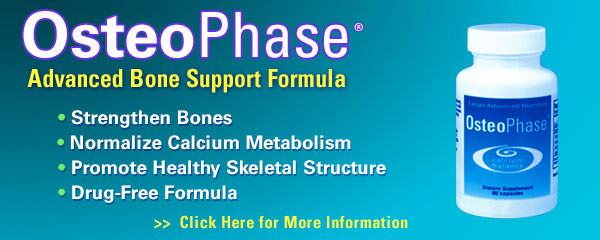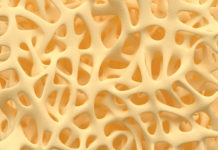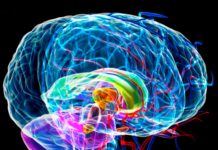By Hyla Cass, MD
Recently, one of my long-time patients, a 78-year-old woman named Jean, called to tell me that her Beverly Hills endocrinologist was astounded by improvements in her bone density, as revealed by a recent DEXA scan. Her previous scan, conducted in August 2005, had shown that Jean suffered significant bone loss in the femoral neck of her hip (osteoporosis), and mild bone loss in her lumbar spine (osteopenia). Her endocrinologist wanted to know how Jean had reversed her history of progressive bone loss, especially since she had refused to take the Fosamax he’d prescribed. (I agreed with her decision at the time, since this medication causes increased bone brittleness, as well as other serious side effects.)
Up to that point Jean had been taking my usual prescription for osteoporosis therapy, which included calcium, magnesium, boron, vitamin D and strontium. This was apparently not doing the job, so I advised her to add OsteoPhase®, a unique herbal bone-support formula that I had just discovered, which aids in restoring calcium regulation in the body.
Calcium Regulation
The problem with calcium supplementation is not how calcium is absorbed and digested in the digestive tract, but how it is regulated by the endocrine system. Once calcium and other mineral nutrients required for bone health have been absorbed, the real issue becomes how the body goes about regulating these nutrients.
Calcium regulation in the body is a complex process guided by feedback systems under the control of hormone/ endocrine systems with the hypothalamus as the master gland in charge.
The bones serve as a primary storage reservoir for calcium in the body and the hypothalamus adjusts the storage levels depending on needs for calcium in other tissues of the body. Since every single cell regulates many of its functions with calcium-based mechanisms, this adjustment is crucial to everything that pertains to our health. For example, every action of all of our muscles, every contraction and relaxation, every single movement we make, is controlled by a calcium-dependent mechanism.
As we age, the hypothalamus begins to function less efficiently. One result is improper regulation of calcium, such that the storage depots of calcium in the bones begin to be depleted, particularly in the hips, lower spine and wrists. This contributes to less bone strength, or bone mass density. When the loss of bone mass density is severe enough it is called osteoporosis, which dramatically increases the risk of fracture and subsequent, long-term debility.
When calcium regulation starts to fail, calcium floods into the soft tissues where it can accumulate and begin to calcify. Calcification occurs primarily in the arteries, heart valves, kidneys, and brain cells.
That is what makes OsteoPhase, a blend of traditional Chinese bone-support herbs, so different from mere supplementation, because it appears to regulate calcium activity. It helps to replenish bone stores of calcium [absorption of calcium into bone tissue] where the calcium then contributes to bone strength. OsteoPhase also prevents calcium from flooding into the body and accumulating in other tissues. This capability comes from a unique (and costly) proprietary extraction process used to capture certain proteins in the oyster shell that are responsible for how the oyster regulates calcium. The oyster shell functions for the oyster much like our bones do for us, as an important support skeleton and reservoir for calcium storage.
DEXA Scan Reveals Improvement
After taking the formula for one year Jean’s follow up DEXA scan revealed a truly remarkable improvement. She had gained 3.3% bone density in her lumbar spine, indicating a normal bone density reading normally seen in a healthy 30-year old woman.
The results for the scan of the femoral neck of her hip were even more remarkable – showing an increase of 9.9% in bone mass density, reflecting a change in her diagnosis from osteoporosis to osteopenia.
The importance of this improvement in bone mass density in the femoral neck of her hip cannot be underestimated. It is typical for women at her age to lose about 1% of their BMD in the femoral neck per year. Instead, she experienced a 9.9% improvement!
Determining Fracture Risk
According to the Surgeon General’s annual report in 2004, there are 1.5 million osteoporosis-related fractures every year. These fractures generate 2.6 million doctor visits and 800,000 trips to the emergency room, resulting in 500,000 hospitalizations annually. Disability from these fractures also results in 180,000 sufferers being placed in nursing homes.
Osteoporosis-related fractures commonly occur in the hip, spine, and wrist. Hip fractures are the most serious, as approximately 25 percent of patients over 50 years of age die within one year of suffering a fracture. Of those who do recover from a hip fracture, only 15% regain enough mobility to walk across a room unaided within one year.
The most serious osteoporotic fracture occurs in the femoral neck. This type of fracture is painful, requiring hospitalization and causing considerable morbidity and mortality.
Because of its structure and composition, the neck of the femur bone in the hip is particularly vulnerable to fracture from the type of twisting falls common in the elderly. The nature of the fracture makes it particularly difficult to heal.
Femoral neck fractures frequently disrupt the blood supply to the femoral head. The progressive disruption of the blood supply can lead to serious clinical conditions and complications, including osteo-necrosis and non-union.
Summary
These DEXA scan numbers reveal a surprising level of improvement, and are even more remarkable given the age of this patient. The improvement in BMD score of the femoral neck reflects a reduction in fracture risk of 125% over her previous score from just one year earlier. After reviewing my notes carefully the only difference I can attribute to her improvement is the addition of the herbal formula to her regimen. Needless to say, I have placed all of my at-risk women patients on OsteoPhase bone-support formula, including younger ones, since it appears that osteoporosis can occur at any age.
About the Author
Dr. Hyla Cass is one of the country’s foremost authors and speakers on the subject of integrative medicine. Dr. Cass has incorporated nutrition and natural health techniques into her practice for more than 20 years. She has written a number of popular books including 8 Weeks to Vibrant Health, which has all the information women want to know about osteoporosis, hormones, mood swings, thyroid, adrenal, candida, chronic fatigue, and weight management.















